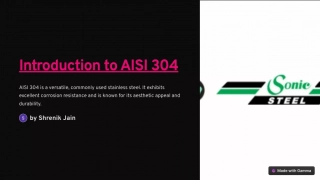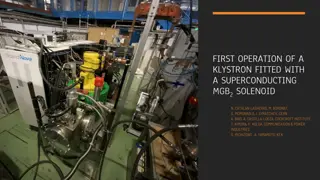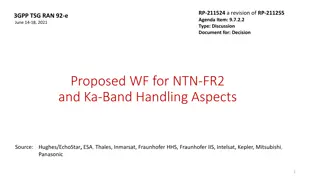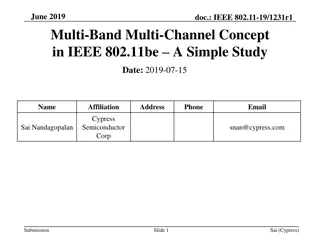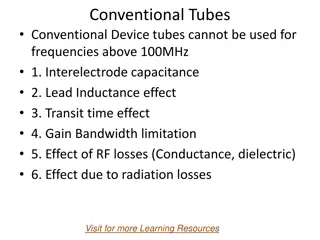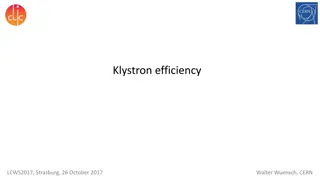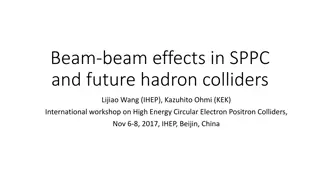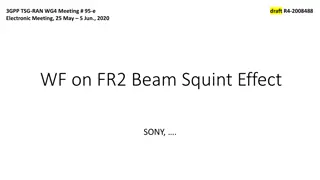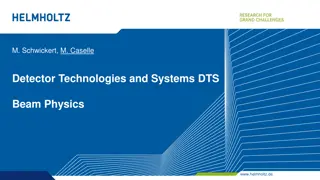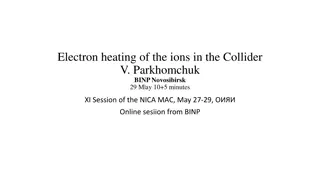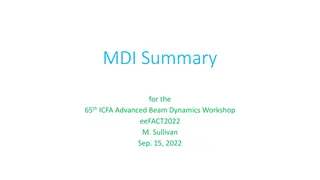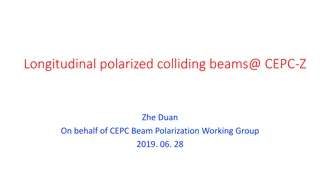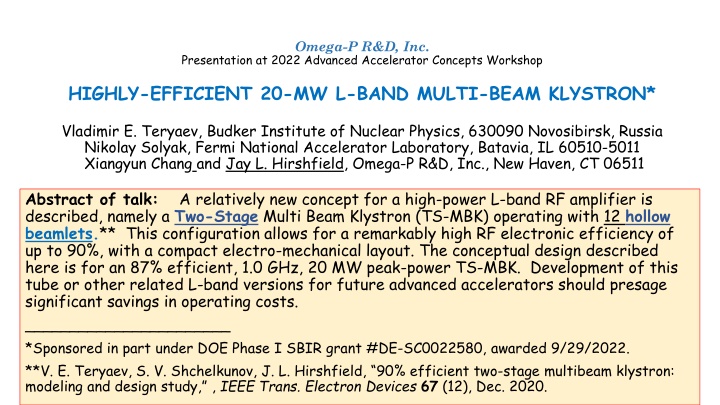
HIGHLY-EFFICIENT 20-MW L-BAND MULTI-BEAM KLYSTRON
Presented at the 2022 Advanced Accelerator Concepts Workshop, this presentation discusses the development of a highly efficient 20-MW L-Band multi-beam klystron. The work was carried out by Vladimir E. Teryaev from the Budker Institute of Nuclear Physics in Novosibirsk, Russia, and Nikolay Solyak from Fermi National Accelerator Laboratory in Batavia, IL. Collaborators Xiangyun Chang and Jay L.
Download Presentation

Please find below an Image/Link to download the presentation.
The content on the website is provided AS IS for your information and personal use only. It may not be sold, licensed, or shared on other websites without obtaining consent from the author. If you encounter any issues during the download, it is possible that the publisher has removed the file from their server.
You are allowed to download the files provided on this website for personal or commercial use, subject to the condition that they are used lawfully. All files are the property of their respective owners.
The content on the website is provided AS IS for your information and personal use only. It may not be sold, licensed, or shared on other websites without obtaining consent from the author.
E N D
Presentation Transcript
Omega-P R&D, Inc. Presentation at 2022 Advanced Accelerator Concepts Workshop HIGHLY-EFFICIENT 20-MW L-BAND MULTI-BEAM KLYSTRON* Vladimir E. Teryaev, Budker Institute of Nuclear Physics, 630090 Novosibirsk, Russia Nikolay Solyak, Fermi National Accelerator Laboratory, Batavia, IL 60510-5011 Xiangyun Chang and Jay L. Hirshfield, Omega-P R&D, Inc., New Haven, CT 06511 Abstract of talk: A relatively new concept for a high-power L-band RF amplifier is described, namely a Two-Stage Multi Beam Klystron (TS-MBK) operating with 12 hollow beamlets.** This configuration allows for a remarkably high RF electronic efficiency of up to 90%, with a compact electro-mechanical layout. The conceptual design described here is for an 87% efficient, 1.0 GHz, 20 MW peak-power TS-MBK. Development of this tube or other related L-band versions for future advanced accelerators should presage significant savings in operating costs. _______________________ *Sponsored in part under DOE Phase I SBIR grant #DE-SC0022580, awarded 9/29/2022. **V. E. Teryaev, S. V. Shchelkunov, J. L. Hirshfield, 90% efficient two-stage multibeam klystron: modeling and design study, , IEEE Trans. Electron Devices 67 (12), Dec. 2020.
Omega-P R&D, Inc. Presentation at 2022 Advanced Accelerator Concepts Workshop HIGHLY-EFFICIENT 20-MW L-BAND MULTI-BEAM KLYSTRON
Omega-P R&D, Inc. Presentation at 2022 Advanced Accelerator Concepts Workshop HIGHLY-EFFICIENT 20-MW L-BAND MULTI-BEAM KLYSTRON Concept of a two-stage multibeam klystron
Omega-P R&D, Inc. Presentation at 2022 Advanced Accelerator Concepts Workshop HIGHLY-EFFICIENT 20-MW L-BAND MULTI-BEAM KLYSTRON Beam optics is simplified by use of immersed cathodes. 12 hollow 12-A, 30-kV beamlets, in a 0.14T magnetic field, are placed around a 90- mm circle, each with perveance of 2.3 A/V^1.5.
Omega-P R&D, Inc. Presentation at 2022 Advanced Accelerator Concepts Workshop HIGHLY-EFFICIENT 20-MW L-BAND MULTI-BEAM KLYSTRON Image below shows the outline along one beamlet axis for the 1000 MHz two- stage multibeam klystron (TS-MBK). RF circuit length is about 1100 mm.
Omega-P R&D, Inc. Presentation at 2022 Advanced Accelerator Concepts Workshop HIGHLY-EFFICIENT 20-MW L-BAND MULTI-BEAM KLYSTRON The first RF stage ( buncher ) comprises six cavities operating in coaxial TM010 modes, the third of which is second harmonic. Hollow beamlets allow for high beam current harmonics after PA gap.
Omega-P R&D, Inc. Presentation at 2022 Advanced Accelerator Concepts Workshop HIGHLY-EFFICIENT 20-MW L-BAND MULTI-BEAM KLYSTRON The post-acceleration gap would allow radiation loss (at left) that lowers the tube s efficiency. Our rejection filter design reduces loss from 47 kW to 37 W.
Omega-P R&D, Inc. Presentation at 2022 Advanced Accelerator Concepts Workshop HIGHLY-EFFICIENT 20-MW L-BAND MULTI-BEAM KLYSTRON RF beam dynamics, modeled using equivalent MAGIC-2D, shown (at left) for one annular beamlet. Particle dynamics, energy distribution, and harmonic currents shown (at center); power balance and beam deceleration in output gap (at right).
Omega-P R&D, Inc. Presentation at 2022 Advanced Accelerator Concepts Workshop HIGHLY-EFFICIENT 20-MW L-BAND MULTI-BEAM KLYSTRON Power output from one beamlet (at left), and RF efficiency vs drive power (at right).
Omega-P R&D, Inc. Presentation at 2022 Advanced Accelerator Concepts Workshop DESIGN PARAMETERS FOR 20-MW L-BAND TS-MBK Operating frequency Beam voltage at the 1st stage Net beam voltage at the 2nd stage Total beam current Number of beamlets Beamlet perveance in the 1st stage Beamlet perveance in the 2st stage Saturated external output RF power Ohmic loss in wall of output cavity Electronic efficiency Output RF efficiency Saturated power gain Peak electric field in output cavity Cathode loading Focusing magnetic field Solenoid power Collector power (4% duty factor) Length of RF cavity circuit 1000 30 180 144 12 2.31 0.157 22.5 150 87.0 86.6 53 80 2.7 0.14 <10 100 1090 MHz kV kV A A/V3/2 A/V3/2 MW kW % % dB kV/cm A/cm2 T kW kW mm
Omega Omega- -P R&D, Inc P R&D, Inc. . Presentation at 2022 Advanced Accelerator Concepts Workshop HIGHLY-EFFICIENT 20-MW L-BAND MULTI-BEAM KLYSTRON IMPLICATIONS FOR HIGH EFFICIENCY: For the proposed 3-TeV CLIC drive beam, about 1230 1.0 GHz tubes are required, supplying a total average power of 184 MW.. For this, the difference in power demand between 70% and 90% efficient tubes is 59 MW which, for 5000 hrs/year @$0.10/kW-hr is a $29M difference in energy cost per year. Waste heat would be lower by 59 MW for tubes with 90% vs 70% efficiencies. Drriving an industrial accelerator for applications such as replacement of radioactive sources used in sterilization or pollution remediation, requires an efficient (up to) 10- MeV, MW-class electron accelerator such as eCRA,* High efficiency is critical for industrial applications. Thus, development of this MW-class average power, efficient pulsed 20-MW L-band RF source could be a game changer. __________ *Development of eCRA is underway with LDRD support at BNL, recently approved for three more years, beginning in FY23. Stay tuned for the next presentation. No efficient high average power accelerator can be realized without efficient high-power RF sources. Further, 1000 MHz may be optimal for eCRA.

